Welcome! If you’re the proud new parent of a Ragdoll cat or considering bringing one into your home, you’ve chosen a truly special companion. Known for their stunning blue eyes, plush coats, and incredibly docile, affectionate nature, Ragdolls live up to their name. However, these “gentle giants” have specific needs to thrive. This comprehensive guide covers everything you need to know about Ragdoll cat care, ensuring your feline friend lives a long, happy, and healthy life by your side.
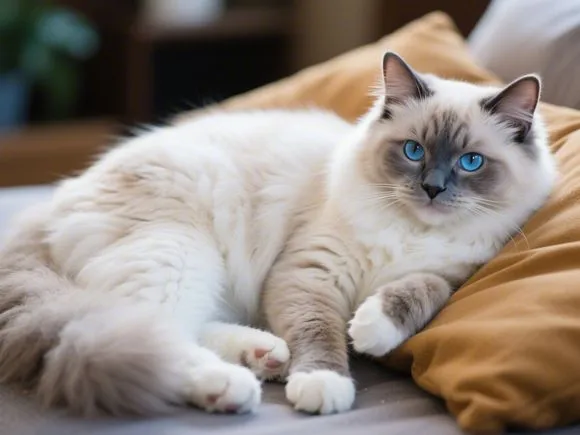
Ragdolls are known for their striking looks and gentle temperament.
Understanding the Ragdoll Breed: More Than Just a Pretty Face
Before diving into care specifics, let’s appreciate what makes a Ragdoll unique:
- Temperament: Ragdolls are famously docile, affectionate, and people-oriented. They often follow their humans around, enjoy being held (sometimes going limp like a ragdoll, hence the name), and possess a gentle, “puppy-like” personality. They crave companionship and generally don’t do well being left alone for very long periods.
- Physical Characteristics: They are one of the largest domestic cat breeds, with a sturdy body, medium-long plush coat (that feels like rabbit fur), and captivating blue eyes. They come in various pointed colors and patterns (like seal, blue, chocolate, lilac, red, cream, often withmitted, bicolor, or van patterns).
- Lifespan: With proper care, Ragdolls typically live between 12 to 17 years, sometimes longer.
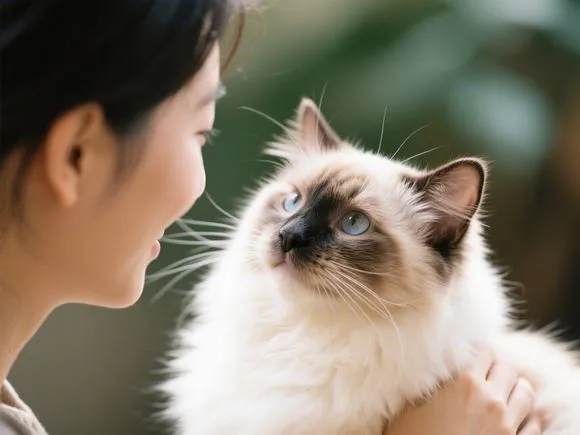
Their people-loving nature is a key characteristic of the Ragdoll breed.
Preparing Your Home for Your Ragdoll Cat
Bringing a Ragdoll home requires some preparation. Ensure you have the essentials ready:
Essential Supplies Checklist:
- Food and Water Bowls: Choose ceramic or stainless steel for hygiene. Ensure the water bowl is always full of fresh water.
- High-Quality Cat Food: Specifics are covered in the next section.
- Litter Box and Litter: Select a large litter box to accommodate their size comfortably. Unscented, low-dust litter is often preferred.
- Scratching Posts/Cat Trees: Essential for nail health and satisfying natural scratching instincts. Choose sturdy options, ideally with vertical space.
- Comfortable Bed: A soft, cozy spot for naps (though they might prefer your lap!).
- Grooming Tools: A steel comb and a pin brush are vital for their coat.
- Toys: Interactive toys (wand toys, puzzle feeders) keep them mentally stimulated and physically active.
- Carrier: A sturdy carrier for safe transport to vet visits.
Cat-Proofing: Secure loose wires, remove toxic plants (like lilies, which are highly poisonous to cats), keep chemicals and medications out of reach, and ensure windows and balconies are secure.
Creating a Safe Space: Designate a quiet room or area where your new Ragdoll can initially settle in and feel secure before exploring the rest of the house.
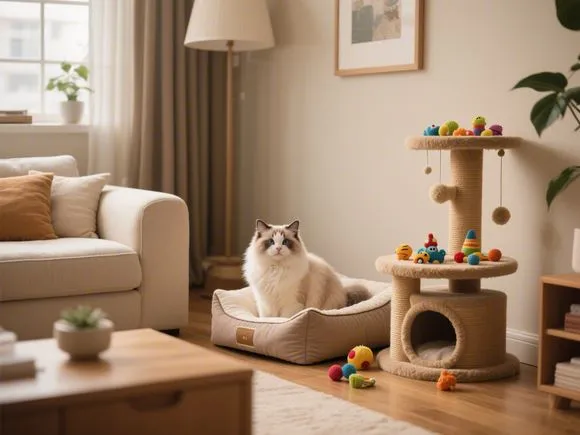
Prepare your home with essentials to welcome your Ragdoll.
Feeding Your Ragdoll Cat: Nutrition for a Gentle Giant
Proper nutrition is fundamental to your Ragdoll’s health, especially given their large size and predisposition to certain health issues.
- Choosing the Right Food: Look for food high in animal protein, moderate in fat, and low in carbohydrates.
- Wet vs. Dry Food: A mix often works well. Wet food helps with hydration, which is crucial for kidney health. Dry food can help slightly with dental hygiene but shouldn’t be the sole diet.
- Life Stage Formulas: Choose food appropriate for their age (kitten, adult, senior).
- Consult Your Vet: Always the best resource for personalized dietary recommendations, especially if your cat has sensitivities or health conditions.
- Feeding Schedule and Portion Control: Ragdolls can be prone to obesity. Stick to recommended portion sizes based on the food label and your vet’s advice. Feeding scheduled meals (2-3 times a day for adults) is generally better than free-feeding.
- Fresh Water: Ensure constant access to fresh, clean water. Some Ragdolls enjoy cat fountains, which encourage drinking.
- Treats: Offer treats sparingly (less than 10% of daily calories). Use them for training or bonding.
- Foods to Avoid: Never give your cat chocolate, onions, garlic, grapes, raisins, alcohol, caffeine, or xylitol.
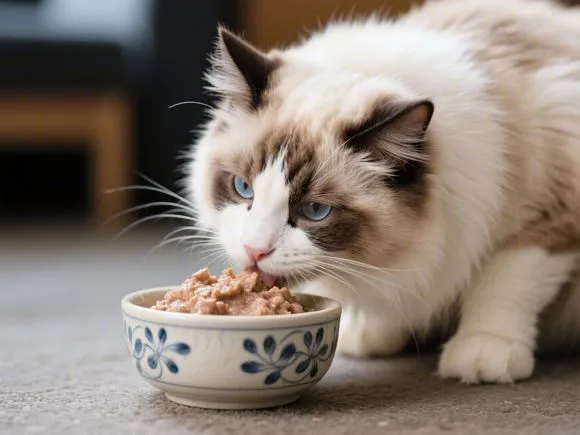
High-quality food and portion control are key to a healthy Ragdoll diet.
Grooming Your Ragdoll: Keeping Their Coat Beautiful and Healthy
While Ragdolls have semi-longhair coats, they lack a dense undercoat, making them less prone to matting than some other longhaired breeds. However, regular grooming is still essential.
- Brushing:
- Frequency: Aim for brushing at least 2-3 times a week, potentially daily during shedding seasons, to remove loose hair and prevent mats (tangles).
- Tools: A stainless steel comb is excellent for working through the fur and finding small tangles. A slicker brush or pin brush can help with overall smoothing.
- Technique: Be gentle. Pay extra attention to areas prone to matting like behind the ears, under the ‘armpits,’ on the belly, and around the tail base. Make it a positive bonding experience with praise and treats.
- Bathing: Generally not required often unless they get particularly dirty. If you do bathe them, use a cat-specific shampoo and rinse thoroughly.
- Nail Trimming: Trim their nails every few weeks using cat nail clippers. Avoid the quick (the pink part).
- Dental Care: Regular tooth brushing with cat-specific toothpaste is ideal for preventing dental disease. Dental treats or water additives can supplement brushing.
- Ear Cleaning: Check ears weekly for wax buildup or signs of infection. Clean only if necessary using a vet-approved ear cleaner and cotton balls (never Q-tips).
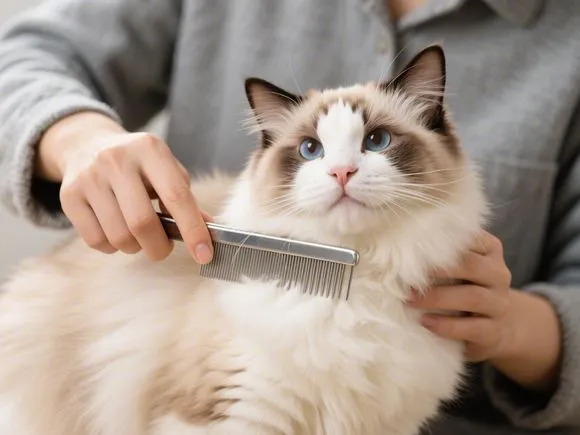
Regular grooming prevents mats and keeps your Ragdoll’s coat healthy.
Health and Veterinary Care for Your Ragdoll
Proactive veterinary care is crucial for catching potential issues early.
- Regular Vet Check-ups: Annual check-ups (or semi-annual for seniors) are vital for vaccinations, parasite control (fleas, ticks, worms), dental checks, and overall health monitoring.
- Common Ragdoll Health Issues: Be aware of conditions more prevalent in the breed:
- Hypertrophic Cardiomyopathy (HCM): A heart condition causing thickening of the heart muscle. Reputable breeders screen for this, and regular vet checks can help monitor heart health.
- Polycystic Kidney Disease (PKD): A condition where cysts form on the kidneys. DNA testing is available.
- Obesity: Their large frame and sometimes lower activity levels make them prone to weight gain.
- Dental Issues: Common in many cats, preventable with good care.
- Hairballs: Due to their coat, regular grooming helps minimize hair ingestion.
- Signs of Illness: Watch for changes in appetite, thirst, energy levels, litter box habits, breathing difficulties, vomiting, diarrhea, or hiding. Contact your vet if you notice anything concerning.
- Spaying/Neutering: Essential for preventing unwanted litters and reducing the risk of certain cancers and behavioral issues.
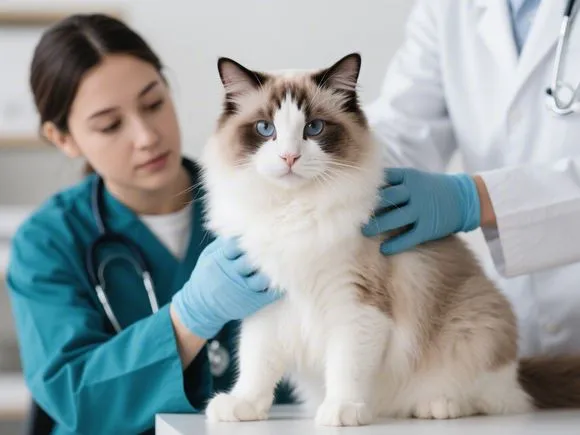
Regular vet visits are crucial for preventative care and early detection of health issues.
Creating an Enriching Environment and Playtime
Ragdolls are intelligent and need mental and physical stimulation to stay happy.
- Litter Box Management: Follow the “N+1” rule (one box per cat, plus one extra). Choose large boxes, place them in quiet, accessible locations, and scoop daily. Wash boxes thoroughly weekly.
- Scratching Needs: Provide multiple scratching options (vertical posts, horizontal pads) with different materials (sisal, cardboard).
- Vertical Space: Ragdolls enjoy climbing. Cat trees, shelves, or window perches provide great vantage points and exercise.
- Play and Interaction: Engage in daily interactive play sessions using wand toys, laser pointers (always end the session by letting them ‘catch’ a physical toy), or balls. Puzzle toys can provide mental stimulation when you’re busy. Remember, Ragdolls thrive on human interaction!
- Safe Outdoor Access (Optional): The safest option is to keep Ragdolls strictly indoors. If you want to offer outdoor time, use a secure ‘catio’ (cat patio) or harness-and-leash training for supervised excursions only.
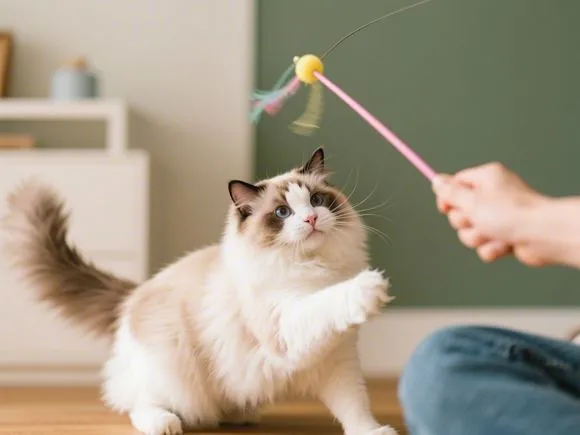
Playtime and environmental enrichment are vital for a Ragdoll’s well-being.
Understanding Ragdoll Behavior and Gentle Training
Ragdolls are generally well-behaved and intelligent, making them relatively easy to train.
- Typical Behaviors: Expect a cat that follows you, greets you at the door, enjoys cuddling, and communicates with soft chirps or meows.
- Litter Box Training: Usually straightforward; show them the box upon arrival.
- Socialization: Early positive exposure to different people, sounds, and gentle handling helps them grow into well-adjusted adults.
- Handling: Most Ragdolls tolerate or enjoy being picked up and held. Always support their body properly.
- Addressing Potential Issues: Their strong bond can sometimes lead to separation anxiety if left alone too frequently or for long stretches. Provide enrichment and consider a companion if appropriate. Use positive reinforcement (treats, praise) for training.
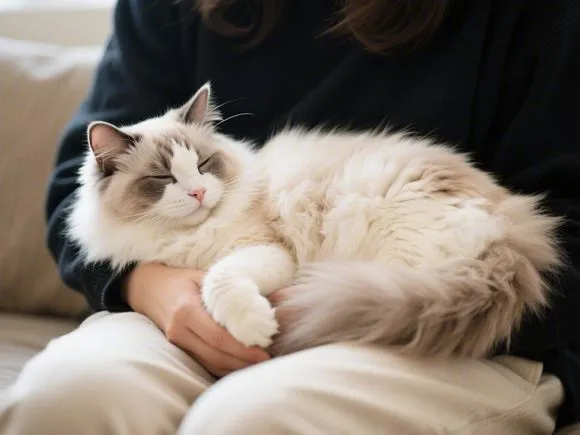
Understanding and nurturing their gentle nature is key to a strong bond.
Safety First: Keeping Your Ragdoll Out of Harm’s Way
Prioritize your Ragdoll’s safety within your home.
- Indoor vs. Outdoor: Keeping Ragdolls indoors is strongly recommended. It protects them from traffic, predators, diseases, poisons, getting lost, or being stolen.
- Household Hazards: Regularly check for potential dangers: toxic plants, cleaning supplies, medications, small objects they could swallow (like string or rubber bands), electrical cords, and open washing machines/dryers.
- Window and Balcony Safety: Ensure screens are secure and supervise any balcony access closely or make it fully enclosed.
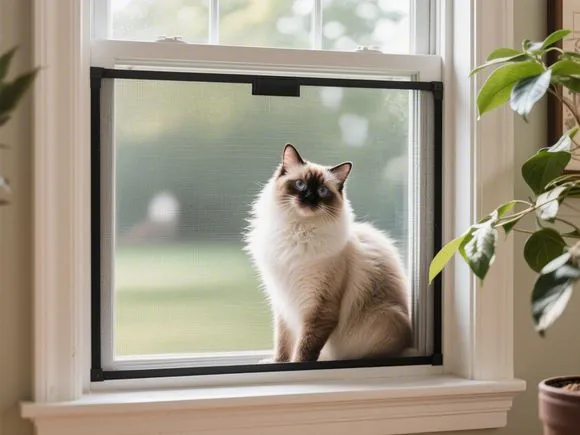
An indoor life and a cat-proofed home are the safest options for a Ragdoll.
Special Considerations for Ragdoll Kittens and Seniors
Care needs change slightly with age:
- Kittens: Require kitten-specific food for growth, more frequent vet visits for vaccinations/deworming, and lots of socialization and gentle play.
- Seniors (typically 10+ years): May need senior-specific food (easier digestion, joint support), more frequent vet check-ups (twice yearly), adjustments for mobility issues (ramps, lower-entry litter boxes), and extra patience.
Conclusion: The Rewarding Journey of Ragdoll Companionship
Keeping a Ragdoll cat happy and healthy involves commitment, particularly regarding grooming, nutrition, health monitoring, and providing plenty of affection and interaction. While they require dedicated care, the love, companionship, and gentle presence they bring into a home are immeasurable. By understanding and meeting their unique needs, you’ll foster an incredible bond and enjoy many wonderful years with your beautiful Ragdoll companion.
Do you have experience caring for a Ragdoll? Share your tips or questions in the comments below!
For more information from reputable sources, consider visiting The Cat Fanciers’ Association (CFA) or The International Cat Association (TICA) websites.